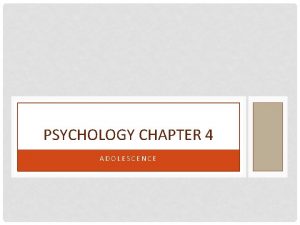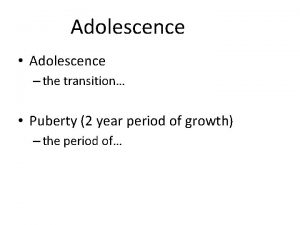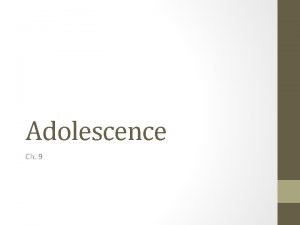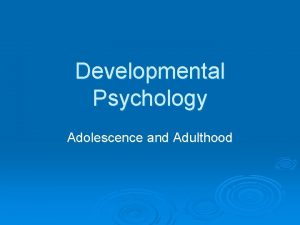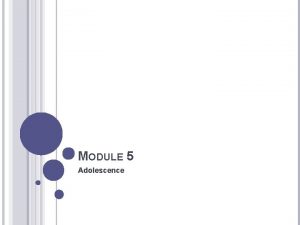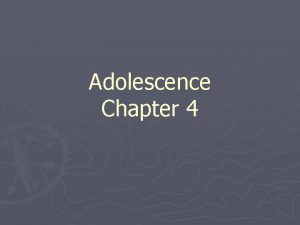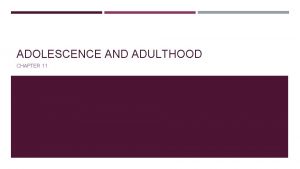Chapter 4 Adolescence Adolescence the transition period from











- Slides: 11

Chapter 4 Adolescence

Adolescence § the transition period from childhood to adulthood § extending from puberty to independence § Puberty § the period of sexual maturation § when a person becomes capable of reproduction

Adolescence § Primary Sex Characteristics § body structures that make sexual reproduction possible § ovaries--female § testes--male § external genitalia § Secondary Sex Characteristics § nonreproductive sexual characteristics § female--breast and hips § male--voice quality and body hair § Menarche (meh-NAR-key) § first menstrual period

Adolescence 1890, Women 10 7. 2 Year Interval 20 Age 1995, Women 12. 5 Year Interval 10 20 Age § In the 1890’s the average interval between a woman’s menarche and marriage was about 7 years; now it is over 12 years

Adolescence Height in centimeters 190 170 150 130 110 90 70 50 0 2 Boys 4 6 8 10 12 14 16 18 Age in years Girls § Throughout childhood, boys and girls are similar in height. At puberty, girls surge ahead briefly, but then boys overtake them at about age 14.

Body Changes at Puberty

Kohlberg’s Moral Ladder Postconventional level Morality of abstract principles: to affirm agreed-upon rights and personal ethical principles Conventional level Morality of law and social rules: to gain approval or avoid disapproval Preconventional level Morality of self-interest: to avoid punishment or gain concrete rewards § As moral development progresses, the focus of concern moves from the self to the wider social world.

Erikson’s Stages of Psychosocial Development Approximate age Stage Description of Task Infancy (1 st year) Trust vs. mistrust If needs are dependably met, infants develop a sense of basic trust. Toddler (2 nd year) Autonomy vs. shame Toddlers learn to exercise will and doubt do things for themselves, or they doubt their abilities. Preschooler (3 -5 years) Initiative vs. guilt Elementary (6 yearspuberty) Competence vs. Children learn the pleasure of applying inferiority themselves to tasks, or they feel inferior. Preschoolers learn to initiate tasks and carry out plans, or they feel guilty about efforts to be independent.

Erikson’s Stages of Psychosocial Development Approximate age Stage Description of Task Adolescence (teens into 20’s) Identity vs. role confusion Teenagers work at refining a sense of self by testing roles and then integrating them to form a single identity, or they become confused about who they are. Young Adult (20’s to early 40’s) Intimacy vs. isolation Young adults struggle to form close relationships and to gain the capacity for intimate love, or they feel socially isolated. Middle Adult (40’s to 60’s) Generativity vs. stagnation The middle-aged discover a sense of contributing to the world, usually through family and work, or they may feel a lack of purpose. Late Adult (late 60’s and up) Integrity vs. despair When reflecting on his or her life, the older adult may feel a sense of satisfaction or failure.

Adolescence: Social Development § Identity § one’s sense of self § the adolescent’s task is to solidify a sense of self by testing and integrating various roles § Intimacy § the ability to form close, loving relationships § a primary developmental task in late adolescence and early adulthood

Adolescence: Social Development § The changing parent-child relationship Percent with positive, warm interaction with parents 100% 80 60 40 20 0 2 to 4 5 to 8 9 to 11 Ages of child in years
 Adolesence period
Adolesence period Non metallic period 3 atomic mass 32
Non metallic period 3 atomic mass 32 Chapter 4 adolescence psychology
Chapter 4 adolescence psychology Chapter 4 adolescence psychology
Chapter 4 adolescence psychology Cynthia lightfoot
Cynthia lightfoot A&p flix activity: generation of an action potential
A&p flix activity: generation of an action potential When is the relative refractory period
When is the relative refractory period Critical period vs sensitive period
Critical period vs sensitive period Critical vs sensitive period examples
Critical vs sensitive period examples Approaches to child development
Approaches to child development Less complicated texture than baroque (more homophonic)
Less complicated texture than baroque (more homophonic) What period is period of activism?
What period is period of activism?


